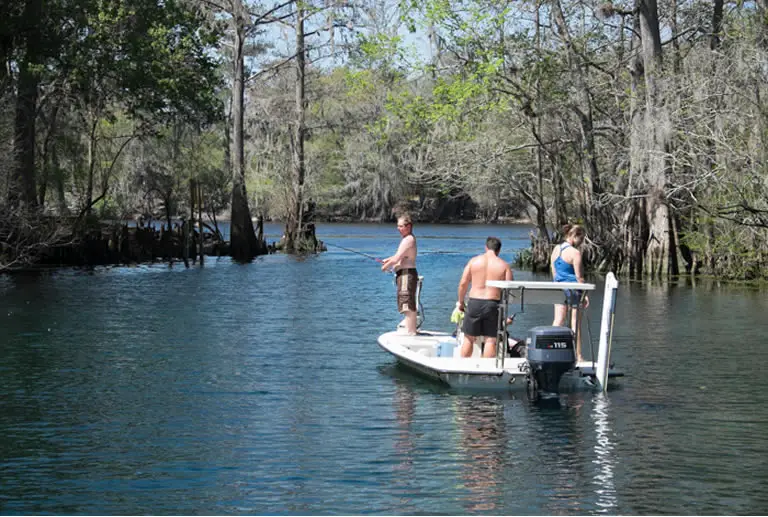Contents
Why Flat Bottom Boats Are Best For Rivers
However, just as larger bodies of water come with some specific boating problems, rivers too can offer their own unique challenges.
For instance, most rivers have extensive shallow areas where a standard v-hull boat would struggle to avoid damage to the bottom of the boat.
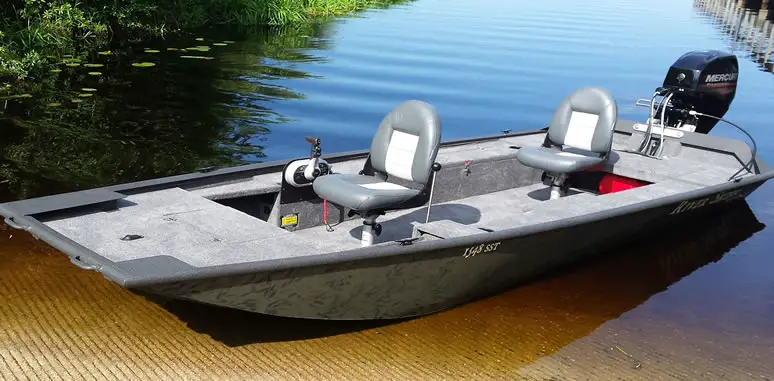
For this reason most river boats are flat-bottomed vessels designed to easily navigate shallow bodies of water.
As well as unprecedented access to shallow waters a flat-bottomed hull design also offers exceptionally stability on calm waters.
Although river boating attracts all kinds of boat enthusiasts, from experienced anglers and hunters to regular pleasure cruisers, rivers offer an excellent marine environment for beginner boaters.
Many public and private rivers offer slips for easy access to the water. In some of the most popular river locations you will find amenities like river marinas and waterside restaurants.
So, if you are new to boating then learning to handle a boat on a river is a great way to start.
If you are a seasoned mariner but new to river boating then you will still get value from this article when it comes to choosing the correct boat for your purposes.
Boat design
One of the most important considerations when river boating is the design of the boat.
Rivers and creeks tend to be shallower than lakes and are, of course, much shallower than the open sea.
A boat designed for open water use would be totally unsuitable for shallow river waters were its deep draft design would cause the bottom of the boat or keel to snag on the river bed.
In most cases an ocean-going vessel, even a small one, would easily run aground in a river.
So, because a river bed can wreak havoc with the bottom of a v-hull boat, this challenge of navigating shallow river waters means you need a flat-bottomed boat.
Flat bottom boats sit high in the water i.e. it has a shallow draft.
A boat with a bottom that sits very close to the water surface is said to have a shallow draft while a boat that sits lower in the water, with its lowest point very deep in the water (such as a keel), is said to have a deep draft.
To better understand the difference between shallow draft and deep draft read this article.
Why a flat bottom is preferred for rivers
Rivers tend to be shallow or have multiple shallow areas.
So, obviously a flat-bottomed boat is preferred for rivers as this type or watercraft can easily clear submerged obstacles, rocks, tree roots, groundings and the riverbed, due to its flat planing hull and shallow draft.
Some flat bottomed vessels can even be readily and deliberately beached.
This allows you to picnic or explore the surrounding area on foot without the need for a slip or marina.
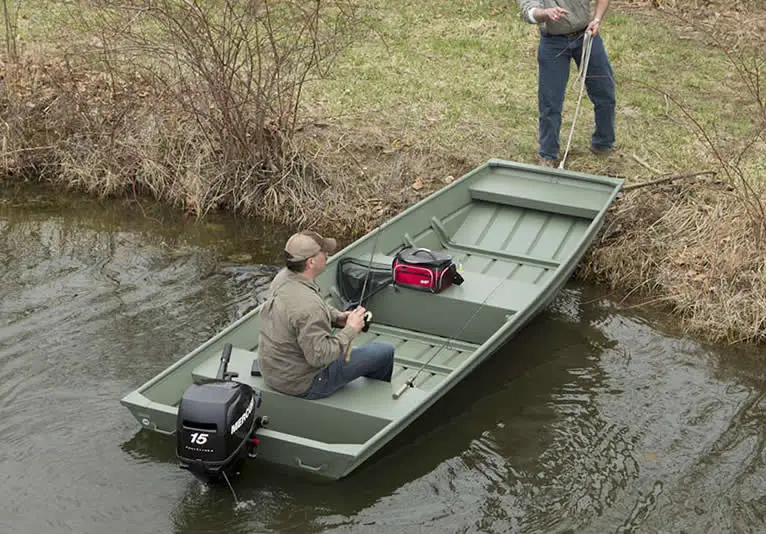
It is not just riverbed vegetation such as grasses or weeds you need to navigate, boating in this type of marine environment also has the added challenges of seasonal tides and occasional strong currents in addition to rapids and rocky areas.
So, you will need a specific flat-bottomed vessel that is not just hardy but that is well suited to the rigors of the rivers you will be commonly navigating.
Thankfully flat-bottomed boats are so diverse that you have a wide range of designs to select from.
They come in all designs from kayaks to Dorys and Jon boats to skiffs to super fast airboats.
Although there are fairly large flat-bottomed river boats in North America, (such as the glass bottom tours in Silver Springs, Florida) and in Europe, the need for a flat bottom river vessel for personal use is likely to limit the size of boat you can take out.
Flat Bottom River Boat Buying Considerations
Here are the essentials you need to look for in a flat bottom river boat.
4 Popular types of personal-use river boat
- The Jon boat is by far the most popular personal-use river boat in America – and for good reason! It is versatile, hardy and stable offering an exceptionally comfortable ride in calm waters even at speed. Its extremely shallow draft means a standard Jon boat can navigate waters that are only a few inches deep. These boats are usually propelled by a trolling motor but can just as easily be moved in the water with a pole, paddle or even oars. Jons are ideal for hunting, angling, bow fishing, utility work, river camping and cruising. Although they are limited to their carrying capacity (see the article Jon boat weight capacity guide) their versatility, low price, low running costs and ease of use makes them one of America’s most popular personal inland water boats. To learn more about these incredible utility boats read this.
- Flat-bottomed skiffs are more often than not used for fishing. Unlike a Jon boat a skiff is usually designed for just one-person use (but not always). Also unlike Jon boats you can get fairly large skiffs that offer a much more comfortable experience, being a cross between a powerboat and a fishing vessel but with a flat bottom. Not all rivers offer a suitable environment for larger skiffs due to the size of the vessel and its inboard motor. Smaller skiffs will be manual propelled or use a trolling motor. If you want a deeper understanding of skiffs read this Wikipedia article.
- Kayaks are also a very popular river boat for a variety of reasons. Although all kayaks have a shallow draft not all of them have a completely flat bottom. River kayaks, for example, have a more rounded bottom and rounded sides because they are designed to ride rapids without capsizing. However, this added safety feature for turbulent waters comes at the cost of stability on calm water; river kayaks tend to feel tippy even though they are difficult to tip. Don’t be confused by the name; river kayaks are designed for sports type usage in turbulent waters. For the majority of river use a flat bottom kayak is best. Flat bottom kayaks offer incredible stability and ease of use on calm waters. To understand how well suited to rivers a flat bottom kayak is read this article. They are used for pleasure cruises and camping and are also often used for fishing and even hunting (though only the sit-on-top kind are suitable for hunting). To understand the difference between sit-on-top and sit-in kayaks read this article.
- Canoes are another popular flat bottom river boat. Just like the kayak the canoe comes in different hull configurations designed for different types of uses and marine environments. A flat bottom canoe offers great stability, ease of use and offers the boater plenty of room for equipment and supplies. They were used by early pioneers and Native Americans for a reason! To see how a flat bottom canoe differs from other canoes in its design, making it perfect for river use, read this article.
If you are unsure about the difference between the benefits of using a kayak vs a canoe and would like to know which one is a better fit for you read this.
Material and fabrication of your flat bottom river boat
Your choice of material will affect the cost and performance of your boat – each has its own benefits.
For a flat-bottomed boat you will typically be choosing between wood, metal (aluminum or steel) or fiberglass.
- Aluminum is commonly used for fabrication of flat bottomed boats, especially Jon boats. It is a robust and lightweight material (which means greater payload and less fuel consumption) and has minimal maintenance needs. It is lighter than steel and is resistant to corrosion (though it erodes fast in saltwater so isn’t suitable for ocean use though many Jon boat owners take to the ocean anyway). Aluminum boats have surprising durability, especially when thicker marine-grade aluminium is used. They are UV resistant making them a great longer term investment. Aluminum and other metals may be either welded or riveted for construction. Welding is a preferred method of fabrication. Welded boats tend to be heavier than riveted boats but are less likely to develop leaks – rivets can loosen with the impacts with obstacles or obstructions in shallow water. When purchasing a welded boat, the quality of the welding will impact the durability of your boat so be sure to follow a good boat buyer’s guide.
- Fiberglass is a cost effective material for a variety of flat-bottomed boat designs and this moulded material is shaped then sprayed with gelcoat and further fiberglass layers as well as resins which cure before being removed from the molding to create a smooth, flat hull with a resilient finish. A major disadvantage however is the development of cracks and fissuring in the fiberglass which can be accelerated and exacerbated by impacts or all kinds and prolonged UV exposure. Crack , though repairable make the boat all the more brittle with time and shortens its lifespan.
- Wood is the traditional material used for creating a boat of any kin, though it is not as popular these days. Wood, however, is cheap and so makes a perfect material for the home boat builder. Wood is also buoyant and very pliable, meaning it can be readily worked into the design of choice. Clearly though, a wooden boat can be progressively degraded by moisture ingress, parasites and rotting. So, unless it is very well looked after it will never last as long as a boat made from alternative materials. Although the method of fabrication and finish will greatly determine the longevity and maintenance needs of a wooden boat, it is regular maintenance that will keep a wooden boat operational for a very long period of time. You can build your own flat bottom river boat from wood easily and cheaply by following the information in this article.
Stability of your flat bottom river boat
If you are a determined river boater, you will need to ensure that your flat bottomed vessel offers maximum resilience and stability on a river.
A completely flat-bottomed boat, such as a Jon boat, can be readily stood-on (you can stand up in the boat without loss of stability).
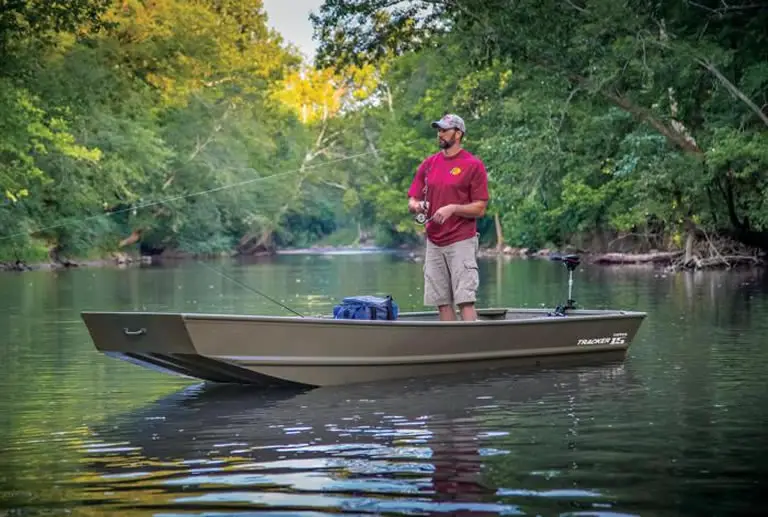
This means accessing gear at the other end of the boat is easy and casting off for fishing can be performed with confidence.
In fact on a flat bottom boat in calm water you can even bow fish from the deck or when standing on a seat.
So, if you intend to boat on regularly calm rivers then a boat with a completely flat bottom is preferable.
If you know that the water may be tidal, very deep (with no shallow areas) or subject to rough waves, or may have other challenging parts such as small rapid, it may be well worth considering a boat with semi-V-hull as this hull type offers better handling rough water.
Jon boats are traditionally flat-bottomed vessels but with such challenging waters in America semi-V Jon boats are also available.
Also look at the chine of the boat you intend to use especially if you are planning to use a kayak or canoe.
A flat bottomed boat with an angular chine offers smooth movement through the water and provides greater speed. Angles always help in cutting through the water.
For an explanation of chine read this.
Your flat bottom river boat motor
Research the type of river you will be navigating and choose an engine of appropriate horsepower to deal with any strong currents that may be present while river boating.
Although a flat bottom boat is adept at shallow water navigation a boat motor isn’t!
Navigating shallow areas of a river where there can be submerged obstacles that are not easily seen can cause your boats motor and propeller damage.
So, always choose a motor that can be readily trimmed where the propeller can be tilted up and out of the water to avoid hitting submerged obstacles or the riverbed in very shallow areas.
There are a number of shallow-water outboards on the market which offer a surface drive propeller and many outboards can be fitted with a metal propeller for added resilience.
Trolling motors are the most popular due to their versatility, light weight and trimming capability.
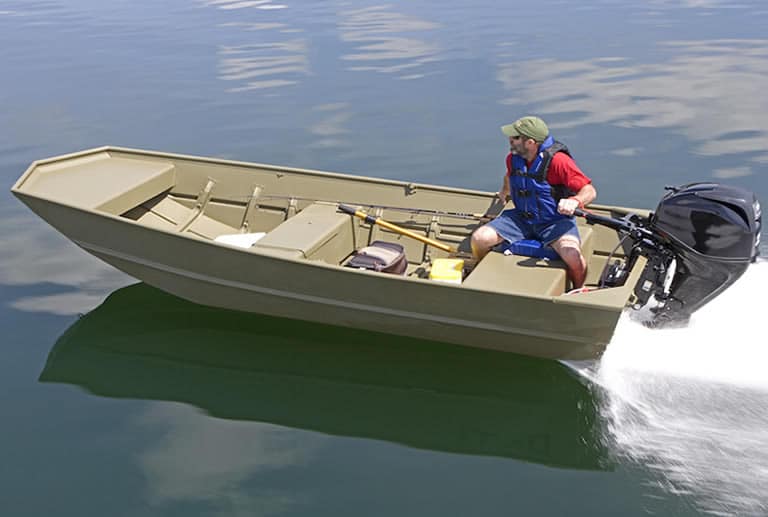
A jet-drive boat is also an option, but if the water is extremely shallow, the engine may suck up sand and mud from the river bottom and become clogged.
Always have some form of manual propulsion on your river boat!
A paddle or pole is an essential onboard item – without one you could find you and your boat are stranded in the middle of a river if your engine develops a problem or should you enter an area with an extremely shallow bank where it is impossible to use your motor.
Additional Things To Look For In A Flat Bottom River Boat
Beyond the basic build of your flat-bottom river boat, it is important to assess your other needs.
Your choice of river boat should also take into account these points:
- Capacity. Look for a capacity plate on your prospective boat which should specify the number of adult passengers, gross load and maximum engine horsepower that can be safely and legally carried by your boat.
- Seating will be necessary according to how you will use your boat. Pedestal seating in particular is a popular choice for anglers. If you will be using your boat in rough water, decent and secure seating is a worthwhile investment as flat-bottomed boats tend to ride rough in choppy water. How many people will be in the boat? Although your boat may have a large weight capacity insufficient seating may mean leaving someone behind.
- Decking. DO you need ample decking space for gear and equipment that you need to hand? Do you plan to stand up on your boat a lot? Many Jon boats can be bought with, or customized to have, an additional bow deck for bow hunting.
- Storage. If you are looking to spend quality time out on the water, fish or hunt then you can never have too much storage. Look for adequate on board stowage for angling gear, camping equipment and a cool/ice box for food and drink or your catch.
- Trailer. Don’t overlook the importance of a reliable trailer to get your boat to and from the water safely.
If you want additional information on choosing a river boat read our article How to Pick the Best Shallow Water River Boat For You.

